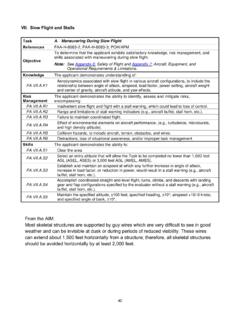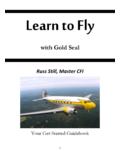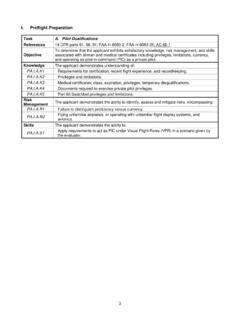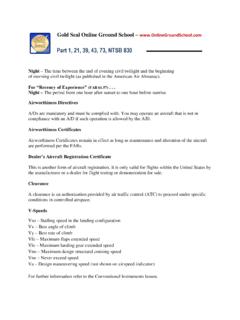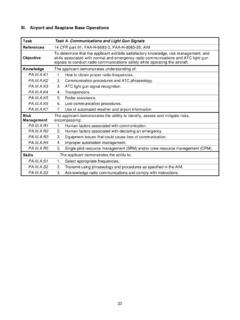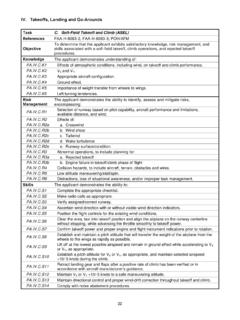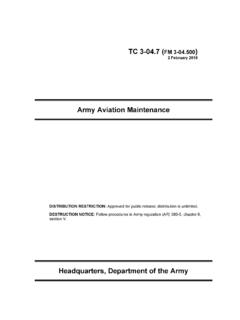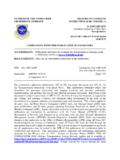Transcription of From the Library at www - Gold Seal Online Ground …
1 1 From the Library at Summary of Maneuvers Private Pilot Airman Certification Standards (ASEL) Traffic Patterns (1) Exhibit knowledge of the elements related to traffic patterns at controlled and uncontrolled fields. (2) Comply with proper traffic pattern procedures and maintain adequate spacing. (3) Correct for wind drift to maintain proper Ground track. (4) Maintain Traffic Pattern Altitude +/- 100 feet. (5) Maintain Appropriate Airspeed +/- 10 knots. Normal and Crosswind Takeoffs and Climbs (1) Position controls for existing wind conditions. (2) Maintain directional control and proper wind drift correction. (3) Lift off at recommended airspeed and accelerate to Vy. (4) Establish pitch attitude to maintain airspeed at Vy +10/-5 knots. (5) Retract flaps (and landing gear) after an appropriate positive rate of climb has been established.
2 (6) Maintain Vy +10/-5 knots until reaching a safe maneuvering altitude. Normal and Crosswind Approach and Landing (1) Establish the recommended approach and landing configuration and airspeed, adjusting pitch and power as necessary. (2) Maintain a stabilized approach at the recommended airspeed +10/-5 knots with wind gust factor applied. (3) Touch down smoothly at the approximate stalling speed. (4) Touch down at or within 400 feet beyond a specified touchdown point, without drift along the runway centerline. (5) Maintain directional control and crosswind correction. (6) Complete after landing checklist. Copyright 2017 by Atlanta Flight, Inc. All Rights Reserved. 2 Soft Field Takeoff and Climb (1) Position controls for existing wind conditions and maximum lift (setting flaps as recommended).
3 (2) Maintain directional control and proper wind drift correction. (3) Clear the area and taxi into the takeoff position without stopping. (4) Smoothly advance the throttle (in a tricycle gear airplane, raising the nosewheel from the surface). (5) Establish and maintain a pitch attitude that will transfer weight from the wheels to the wings as quickly as possible. (6) Lift off at the slowest speed possible and remain in Ground effect until reaching either Vx or Vy as appropriate. (7) Climb out at Vx or Vy +10/-5 knots as appropriate. (8) Retract flaps (and landing gear) after clearing any obstacles or as recommended. (9) Maintain Vy +10/-5 knots until reaching a safe maneuvering altitude. Soft Field Approach and Landing (1) Establish the recommended approach and landing configuration and airspeed, adjusting pitch and power as necessary.
4 (2) Maintain a stabilized approach at the recommended airspeed +10/-5 knots with wind gust factor applied. (3) Touch down softly without drift along the runway centerline. (4) Maintain directional control and crosswind correction. (5) Complete after landing checklist. Short Field Takeoff and Maximum Performance Climb (1) Position controls for existing wind conditions and maximum lift (setting flaps as recommended). (2) Clear the area and taxi into position using all available takeoff area. (3) Apply brakes while advancing throttle smoothly to takeoff power. (Release brakes and begin takeoff roll after maximum power has been achieved.) (4) Lift off at recommended airspeed and climb out at recommended obstacle clearance airspeed or Vx. (5) Establish a pitch attitude that will maintain Vx +10/-5 knots until the obstacle is cleared.
5 (6) After clearing the obstacle, accelerate to Vy and maintain Vy +10/-5 knots during the climb to a safe maneuvering altitude. (7) Retract flaps (and landing gear) after clearing any obstacles or as recommended. Short Field Approach and Landing (1) Consider the wind conditions, landing surface, and obstructions to select the most suitable touchdown point. (2) Establish the recommended approach and landing configuration and airspeed, adjusting pitch and power as necessary. (3) Maintain a stabilized approach at the recommended airspeed +10/-5 knots with wind gust factor applied. (4) Touch down smoothly on the centerline at minimum control airspeed at or within 200 feet beyond the selected touchdown point, maintaining directional control and crosswind correction. (5) Apply brakes to stop in the shortest distance consistent with safety.
6 (6) Complete after landing checklist. Copyright 2017 by Atlanta Flight, Inc. All Rights Reserved. 3 Forward Slip to a Landing (1) Select a suitable touchdown point. (2) Establish a slip attitude at a point from which a landing can be made using the recommended approach and landing configuration and airspeed. (3) Maintain a Ground track along the runway centerline. (4) Touch down smoothly (aligned with the runway centerline) at the approximate stalling speed at or within 400 feet beyond the specified touchdown point, maintaining directional control and crosswind correction. (5) Complete after landing checklist. Go Around/Rejected Landing (1) Make a timely decision to discontinue the approach. (2) Apply takeoff power immediately and transition to a climb pitch attitude for Vy, maintaining Vy +10/-5 knots.
7 (3) Retract landing gear and flaps as appropriate. (4) Maneuver to the side of the runway, parallel to the centerline for traffic avoidance. (5) Maintain Vy +10/-5 knots until reaching a safe maneuvering altitude. Steep Turns (1) Establish the recommended airspeed or a safe airspeed not to exceed Va. (2) Roll into a coordinated 360 turn maintaining 45 of bank. (3) Divide attention between control, orientation, (and traffic avoidance). (4) Maintain the entry altitude +/-100 feet, airspeed +/- 10 knots, and bank angle +/-5 . (5) Roll out on the entry heading +/-10 . Ground Reference Maneuvers (1) Enter the maneuver on the downwind ( with the wind at your back). (2) Begin the maneuver at an altitude between 600 and 1000 feet above Ground level. (3) Apply adequate wind drift correction to maintain Ground track during the maneuver.
8 (4) Divide attention between aircraft control, Ground track, (and traffic avoidance) while maintaining coordinated flight. (5) Maintain altitude +/- 100 feet and airspeed +/-10 knots. Copyright 2017 by Atlanta Flight, Inc. All Rights Reserved. 4 Maneuvering During Slow Flight (1) Select an altitude that will allow the task to be completed no lower than 1,500 feet AGL. (2) Establish and maintain an airspeed at which any change in angle of attack, increase in load factor, or reduction of power will result in an immediate stall warning. (3) Accomplish coordinated straight and level flight, climbs and descents, and turns with any flap configurations. (4) Divide attention between airplane control and orientation. (5) Maintain the specified altitude +/-100 feet, specified heading +/- 10 , airspeed +10/-0 knots and specified angle of bank +/-10.
9 Power-Off Stalls (1) Select an altitude that will allow the task to be completed no lower than 1,500 feet AGL. (2) Establish a stabilized descent in the approach and landing configuration. (3) Transition smoothly to a pitch attitude that will induce a stall. (4) In straight and level flight, maintain heading +/-10 and bank angle not to exceed 20 while inducing the stall. (5) In turning flight, maintain a bank angle not to exceed 10 while inducing the stall. (6) Recover promptly by lowering the nose to reduce angle of attack, increasing power to the maximum allowable power setting, and return to straight and level flight with a minimum loss of altitude. (7) Retract flaps (and landing gear) after a positive rate of climb has been established. (8) Accelerate to Vx or Vy before final flap reduction.
10 Power-On Stalls (1) Select an altitude that will allow the task to be completed no lower than 1,500 feet AGL. (2) Establish takeoff or departure configuration with power set to no less than 65% of available power. (3) Transition smoothly from the departure attitude to the pitch attitude that will induce a stall. (4) In straight and level flight, maintain heading +/-10 and bank angle not to exceed 20 while inducing the stall. (5) In turning flight, maintain a bank angle not to exceed 10 while inducing the stall. (6) Recover promptly by lowering the nose to reduce angle of attack, increasing power to the maximum allowable power setting, and return to straight and level flight with a minimum loss of altitude. (7) If flaps (and landing gear) are extended, retract them after a positive rate of climb has been established.
